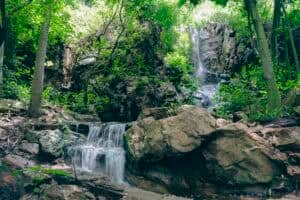Tourists said their driver told them they were taking the horns because a lion had killed the rhino earlier, and needed to get the horns before poachers.

A gruesome discovery by a group of tourists on a night-drive in Kruger National Park earlier this month has raised questions about how a rhino died.
The tourists spotted a man emerging from bushes holding a horn dripping with blood, chopped from a critically-endangered Black rhino carcass, just 15m away.
He and another man, dressed in what appeared to be a uniform, have subsequently been confirmed by SANParks to be employed by the park.
Disturbing sight
A US tourist, who asked only to be identified as “Lilly”, said she and the group of about 20 were deeply disturbed by the bloody sight.
“We had been driving for an hour and a half when we spotted a lion. The driver of our vehicle switched off the engine and then we heard a chopping noise. We saw flashing lights so we knew somebody was there, but we didn’t know what they were doing. Then two men walked out of the bush.
“As they approached our truck, we saw one wearing a SANParks uniform, holding a rifle and an axe. The other guy was wearing a yellow football jersey and sneakers, a little bit behind. As he got closer, we noticed he was carrying a large and a smaller rhino horn. He was very sweaty and out of breath.”
She said the man wearing the uniform then walked to a bakkie parked in the bush about 20m away, “while the man with the rhino horns stopped at our vehicle, apparently in fear of the lion, while he waited for the uniformed man to return in the car. He spoke to our driver in a language we did not understand.”
“Everyone on our vehicle was shocked and concerned. Our driver told us they were taking the horns because a lion had killed the rhino earlier in the day (Tuesday 11 May) and they needed to get the horns before poachers.
“The man holding the horns told us not to take photographs, but everyone was taking pictures; while our driver kept repeating that the rhino was killed by a lion,” she said.
Lilly added that it was “very odd that the man was wearing regular clothing and it was bizarre that the rhino horn was so bloody. It was also odd that the truck was hidden off the road and was not a SANParks vehicle”.
She questioned that “if it was a legal thing, why would they be using an axe, not a chainsaw; and why would they be dehorning a rhino in the dark”.
“The uniformed man pulled the car out of bush and the other man quickly threw the horn in the back, got in and they drove away.
“We started driving and found the rhino carcass, about 10m down the road and five metres into the bush. It was too dark to see any detail, so we drove back to the camp in silence – everyone was shocked.”
Incident ‘reported’
Back at Satara camp, the tourists reported the incident to their host, Bob Venter, who immediately went to report the incident.
Venter found the driver of the night-drive vehicle, who put him on the phone to the “head ranger”, who Venter believes to be the same man seen at the scene of the dehorning – Mr Wilson Silewa.
Venter said the man promised to come to meet them at their chalet in the camp to hear their report of the incident, but that he had never turned up.
The next day, Lilly and two other tourists returned to the scene with Venter and five military personnel.
“There was large hole chopped in the top of the rhino’s head, but there was no sign of any injuries that might have been caused by a lion,” she said.
Later it emerged that that the rhino’s genitals and anus had been cut out.
SANParks denies wrongdoing
SANParks has denied any wrongdoing on the part of Silewa or his colleague.
A spokesperson for Kruger National Park, Isaac Phaahla, referred to Silewa as “one of our most dedicated rangers” and said he, “together with his colleagues, went to recover the horns for safekeeping as per SANPark’s protocols. They were not acting outside their mandate.”
Phaahla went on to say that “a team from the Environmental Crime Investigative Unit has been dispatched to investigate the circumstances around the incident, as is the case with all rhino mortalities that have not clearly died from natural causes”.
Venter was not convinced.
“Why did Mr Silewa not come to meet me at my bungalow as he had said? Why did he not inform the night-drive officials, not to take guests to that location? Or close off the road?
“Why would they de-horn a rhino at night? Why was he using his private vehicle?” he asked.
Venter also criticised SANParks for the “trauma and stress” caused to his guests.
“My visitors come to South Africa to see and support rhinos, but instead are traumatised – driving into the bush to find an unidentified man with rhino horns, dripping with blood.
“This does an enormous damage to our international reputation.”
A South African National Defence Force official, who identified himself only as Lieutenant Tshoba, confirmed the incident and said they were “following up with the Area Manager of Satara, Mr Wilson Silewa”.
He also confirmed that Silewa was the SANParks official seen at the scene of de-horning the rhino.
The Defence Department’s Siphiwe Dlamini said the SANDF had nothing further to add and that SANParks was the responsible authority for the park.
In October 2020, three SANParks officials were arrested in possession of rhino horns and the park is planning to polygraph all officials and personnel dealing with endangered species such as rhino.






